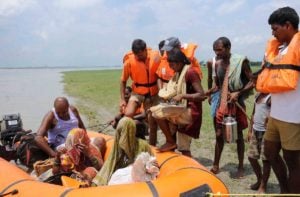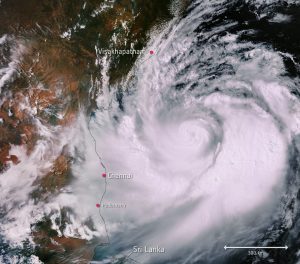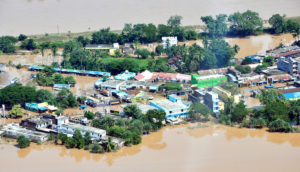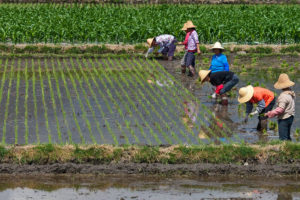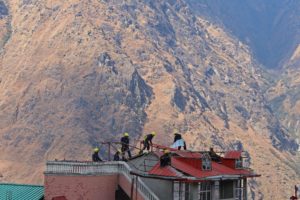In a world where climate change is increasing the frequency and severity of extreme weather events, early warning systems that allow affected people to respond in time to avoid tragedy are only growing in importance.
In recent years, the early warning services of the India Meteorological Department (IMD) have saved thousands of lives and avoided millions in economic damage in South Asia. IMD is the nodal centre for South Asia under the World Meteorological Organisation’s Severe Weather Forecasting Programme (SWFP). The specific programme for South Asia was initiated in 2011 for nine countries: Bangladesh, Bhutan, India, Maldives, Myanmar, Nepal, Pakistan, Sri Lanka and Thailand.
The IMD’s weather forecasts and risk impact-based pre-event advisories have minimised damage to sectors from agriculture to shipping and aviation. In one example from May 2021, Cyclone Yaas was tracked all the way from the Andaman and Nicobar Islands across the Bay of Bengal until it made landfall along the coastlines of Odisha and West Bengal. As a result of precise warnings – conveyed through television, newspapers and loudspeaker announcements – over a million people in the path of the storm were evacuated to cyclone shelters. The final death toll was 20 – this figure could have been in the thousands if residents had not been evacuated.
The specialised coastal weather bulletins that the IMD produces – which include coastal inundation warnings – can be of help to coastal populations, fishers and shipping, not only in India but in all neighbouring countries. The IMD also serves as the region’s numerical weather prediction (NWP) centre, and South Asia’s centre for severe weather forecast and tropical cyclone forecast support, making it a key part of the WMO’s global forecasting networks.
Now, this regional hub is being strengthened with the approval at the last UN climate summit – COP27 in Egypt – of a USD 3.1 billion plan to improve early warning systems across the world. Specifically, the IMD is planning to improve the way it shares weather warnings with vulnerable populations throughout South Asia, including by popularising its specialised services for farmers and fishers.
How the IMD’s early warning systems work
The IMD has a large network of observation systems, computers and experts who decipher information arriving constantly through satellites, radars, and automatic and manual weather stations across India. The IMD uses this information to prepare weather advisories and warnings for farmers and fishers. The IMD’s regional services are supported by the National Centre for Medium Range Weather Forecasting (NCMRWF), the Indian National Centre for Ocean Information Services (INCOIS) and the Indian Institute of Tropical Meteorology (IITM).
IMD warnings have enabled South Asia to better forestall cyclone damage. Casualties from cyclones in the region – such as of Cyclone Bhola in Bangladesh (1970) and the 1999 supercyclone in Odisha – used to number in the thousands. Now, thanks to early warning systems, with the IMD able to accurately forecast the cyclone path and enabling potential victims to move to safety well on time, casualties are in the dozens.
Partnership through other regional groups
The IMD collaborates with several regional entities to share warnings. These include the South Asian Association for Regional Cooperation (SAARC), with its eight member countries Afghanistan, Bangladesh, Bhutan, India, Maldives, Nepal, Pakistan and Sri Lanka; and the Bay of Bengal Initiative for Multi-Sectoral Technical and Economic Cooperation (BIMSTEC), of which Bangladesh, Bhutan, India, Myanmar, Nepal, Sri Lanka and Thailand are members. The IMD plays a key role in BIMSTEC in providing scientific inputs on climatic hazards and early warnings.
The latest international initiative is the Coalition for Disaster Resilient Infrastructure (CDRI), a global initiative by the government of India which, in collaboration with the IMD, is developing resilient housing, communication, power supply, mobility and transportation solutions. These will be rolled out both within and outside India.
Research in a climate changed world
As global warming affects sea surface temperatures, leading to more ocean heatwaves, the IMD is accelerating its oceanic atmosphere research programmes. The interaction between the ocean and the atmosphere is responsible not only for extreme weather events such as cyclones, but also the monsoon rainfall upon which all South Asia depends. The IMD is coordinating regional research efforts in this crucial area through INCOIS.
A global rise in extreme weather events has been impacting Asian countries in particular due to geographical and socio-economic vulnerabilities. But China and India are the only countries in mainland Asia with high-cost observation systems and state-of-the-art computational devices. That is why the services provided by the IMD can be of such benefit across the region.
This work is part of a collaborative editorial series between the World Bank, ICIMOD and The Third Pole that brings together climate experts and regional voices on “Regional Cooperation for Climate Resilience in South Asia”. The views and opinions expressed by the author are her own. The series has been funded by the United Kingdom’s Foreign, Commonwealth and Development Office through the Program for Asia Resilience to Climate Change – a trust fund administered by the World Bank.


